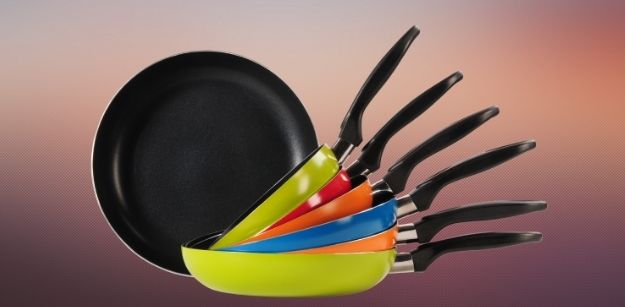Cookware is one of the best investments you can make for your home. Unfortunately, picking the best cookware, especially frying pans can be a hassle. How so? — There are so many options that choosing the best frying pan can be challenging.

Well, this article is a guide on the popular types of frying pans to help you in your next purchase. But first, here are some questions to ask yourself before you venture into buying a new frying pan:
The Basics of Choosing the Best Type of Frying Pan
When shopping for a new frying pan, the first thing to consider is the many types available. If you are a beginner, you will almost certainly require some help in choosing the type. Some essential questions to ask yourself in this situation include:
- What is your budget?
- What are you going to cook in it?
- Is it important for me to have low-maintenance cookware?
- How many people will you be cooking for?
- What’s your level of skill?
Top 7 Types of Frying Pans
1. Uncoated Aluminum
Aluminum is lightweight, inexpensive, and excellent at dissipating heat. However, because it does not maintain heat efficiently, the temperature will change as food is added to a hot pan.
Unfortunately, raw aluminum is extremely reactive to alkaline or acidic foods. It’s also incredibly soft, prone to warping under high heat and scratching readily, posing health risks over time. As such, it’s not recommended.
2. Cast Iron
All kitchens should have cast-iron frying pans. They are sturdy pans and are ideal for a variety of meals. They also distribute heat evenly, allowing you to cook food evenly. As if that’s not enough, they’re great for achieving a beautiful sear on dishes like pan-fried chicken and steak cooked in a cast-iron skillet.
However, don’t limit yourself to meats; try bread, skillet meals, and other recipes as well. Note that cast iron pans can simply transition from burner to oven and even over-the-campfire pans. On the flip side, these pans do require a little additional attention, but with a few simple cleaning instructions and frequent seasoning, you can keep this pan in use for a long time.
3. Carbon Steel
Carbon steel resembles cast iron in appearance. Like their cast-iron counterparts, they require seasoning and grow more nonstick over time. They can be used for everything from meats to eggs to fish and vegetables if properly seasoned.
However, carbon steel does not retain heat as well as cast iron since it is thinner and lighter. This isn’t always a good or negative thing; it simply implies the pan is more sensitive to temperature variations. It will heat up faster, but it will also cool down faster. Overall, it’s a terrific all-purpose pan that’s a good alternative to cast iron.
4. Nonstick-Coated
Aluminum pans coated with Teflon or PTFE provide a nonstick cooking surface that can be used with little or no oil. They’re made for delicate dishes like crepes, eggs, and fish. These pans are a must-have if you frequently make eggs.
Nonstick aluminum pans are affordable but require some upkeep: they must be hand-washed and cannot be used with metal utensils. Scratching the pan’s surface can cause the coating to flake, something you don’t want to happen.
5. Ceramic-Coated
Nonstick pans with a ceramic coating are often referred to as “green” nonstick pans. They’re coated in a sand-based silica-based gel that creates a smooth, nonstick surface without the use of chemicals. These pans are better for cooking at a lower temperature—no searing here. When you need nonstick functionality without the use of chemicals, they are a fantastic choice.
6. Hard-Anodized Aluminium
This is yet another nonstick option that is a great all-around frying pan. The nonstick characteristics come from the way the pan is made, not from any form of coating; a method that makes such pans stronger than regular aluminum.
In hard-anodized aluminum, you can get a good sear while also getting the nonstick characteristics you need for foods like pancakes and eggs. On the flip side, they have one limitation—don’t put them in the oven.
7. Stainless Steel
Although it’s a fantastic all-purpose frying pan material, it is not a good heat conductor on its own. As such, opt for pans that are tri-ply or multi-ply, which are manufactured by fusing multiple layers of metal, usually stainless steel, aluminum, and occasionally copper.
Although they are heavier than single-layered pans, they are still lighter than cast iron. Stainless steel pans are great for baking, preparing sauces, and searing meat. Because these pans aren’t coated, you can cook with them with whatever tools you choose, but keep in mind that you’ll need to grease them because food tends to stick to them.
Bottom Line
Cooking is an art that requires the use of proper cookware to prepare delectable cuisine. Frying pans are used to bake casseroles, fry vegetables, brown meats, and many other uses besides the typical use of frying eggs and bacon. As such, choose your frying pan well!